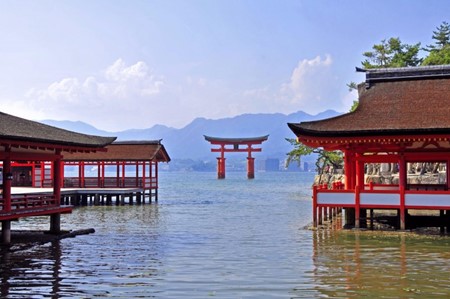We have been getting lots of feedback from clients about when they might feel comfortable enough to take cruise. Although many still have lingering memories of people stranded on ships until they were cleared to disembark, most are feeling that cruise ships are now cleaner and safer than ever before. With strict government regulations regarding cleaning, COVID screening and vaccinations, Paul and I will be back out on the water as soon as we can. And with the crazy pandemic promotions coming to an end, it is a perfect time to start planning. This week I’m going to tell you about Japan, where we will be next year at this time, if the world cooperates😊!
We will be cruising with Celebrity cruise line, departing Tokyo next April. It’s a Transpacific cruise, which means there are several days at sea, and we will disembark the ship in Seattle, Washington 13 days later. We’ve been able to access some group space and at only $4,000CAD per balcony cabin (Total for 2, based on double occupancy), including a drink package, wi-fi, and prepaid gratuities, we think it’s an amazing deal.
Some basic info about Japan ….
The Japanese archipelago is comprised of four main islands and about 6,800 smaller islands. The population is 126 million, more than three times that of Canada. As the country stretches some 3,000 kilometres north to south, it encompasses a range of climates from subarctic to subtropical, with four distinct seasons.
The currency in Japan is the yen, and the official language is Japanese. Although it cannot be said that all or even most Japanese people speak English, English is studied by everyone in the Japanese school system. The typical level of understanding might be compared to the typical Canadian Anglophone’s understanding of French – enough for basic reading and recognition, but seldom prepared for a fast-moving conversation with a native speaker.
We will be arriving during the Cherry blossom season as blooms arrive as early as mid-January in Okinawa and as late as the first week of May in Hokkaido. Cherry blossom viewing parties, known as hanami, are a popular way to admire the transient beauty of these iconic blooms.
Japanese cuisine is much more to than simply sushi and sashimi. Each region has its own local delicacies, and food from many different countries is also expertly represented in Japan, including French, Italian and Chinese. We’ve all heard of ramen, a Japanese favorite that has evolved into a global favourite. As we will see as we travel around the country, these egg noodle dishes vary greatly in soup base and ingredients depending on the region. Eki-ben is a special type of Bento Box meal found at train stations and usually includes a main dish and smaller side dish portion served with rice or onigiri (rice balls). Enjoying eki-ben on a shinkansen ride is a quintessential Japanese experience that we plan to experience!
Nihonshu, known around the world as sake, is a clear-coloured Japanese rice wine. Sake is brewed similarly to the way beer is made, by fermentation with rice, water, koji (malted rice) and yeast. The alcoholic content varies from 13-16%, and it can be enjoyed either hot or cold.
Pre-Cruise
With only a couple of stops in Japan and one interesting one in Russia, we will be arriving in Japan about a week before we get on the ship in order to have enough time to see the areas not captured on the cruise. We’re consulting with our group to ensure we include all the highlights everyone wants to see. Some of the places we’d like to visit and events we’d like to experience are listed below.
What’s a trip to Japan without watching a geisha or maiko (apprentice geisha) perform in a teahouse? These performers have been strictly trained in Japanese traditional arts, including song and dance and musical instruments like the koto (a board zither) and the shamisen (a three-stringed instrument resembling a guitar). If our dates happen to coincide with their schedule, we might be lucky enough to take in a Sumo match. Sumo wrestling is a traditional sport with ancient Shinto origins. There are six tournaments held annually, with one in May.
Hiroshima, where, as we all know, a nuclear bomb exploded on August 6, 1945 is a must see. We can visit one of the only structures that was not completely levelled by the explosion, the Prefectural Industrial Promotion Hall, now known as the A-Bomb Dome which has been preserved untouched. While in that area, the beautiful red Itsukushima Shrine, best known for its “floating” torii gate, stands on the island of Miyajima is just a short ferry ride from mainland Hiroshima. This island was once considered so sacred that it could only be approached through the offshore gate. The shrine acted as a sort of port hovering above land and water, keeping common mortals from setting foot on the island. If we time our visit correctly, perhaps we can walk out to the torii gate at low tide, or there is a ropeway that ascends Mount Misen for stunning views over the island and the bay.
In the southern part of Kagoshima prefecture, we will find Yakushima, a circular island, with six mountain peaks over 1,800 metres high. From these heights descend a number of stunning waterfalls, the largest being the majestic 88-metre Oko Falls. The ancient biosphere here is famed for its cedars, with one known as the Jomon Sugi thought to be around 7,000 years old, assumed to be the largest and oldest in the world. Wouldn’t that be amazing to walk under/through!
To really experience Japan, a visit to a traditional village would be essential. There is a beautiful one resting in the shadows of Mount Hakusan, in Shirakawago making it one of the Gifu area’s must-visit destinations. We may stay in a traditional gassho-zukuri home built without nails – the structure is so sound that these houses have stood since the 1800s and hopefully have time to visit the Tajima House Museum of Silk Culture to learn the history of the silk farming that was so essential to the region.
Three sacred and culturally rich regions lie across Nara, Wakayama and Mie prefectures, reflecting a fusion of Shintoism and Buddhism. The area is prime territory for experiencing a shukubo temple stay and perhaps we’ll try living like a monk for a night.
Mount Fuji is of course the well-known iconic mountain that stands at 3,776 metres tall and is another “must see”. Unfortunately hiking the trails only opens in July so we will have to admire it from afar.
Temples and castles are an important part of a visit to Japan. Some of the best-known temples are in Kyoto’s iconic “Golden Pavilion”. Hyogo is where we will find Himeji Castle. It’s pure white appearance has given it the nickname “White Heron Castle”. The most spectacular of the nation’s 12 remaining original-construction castles, this 400-year-old, six-storey structure boasts more than 1,000 cherry trees on the grounds in spring. It should be spectacular when we are there.
Our Cruise Itinerary
Our cruise embarks from Tokyo, the nation’s capital city with a population of around 13 million people. It is the centre of politics, economy and culture in contemporary Japan. Tokyo has many faces: towering skyscrapers, preserved streets and traditional facades, and tranquil gardens and temples.
After our pre-cruise trip around the outlying areas, we’re planning to arrive in Tokyo a couple days early to take in all the city has to offer. The Japanese capital of Tokyo is a city of contradictions, where ancient traditions coincide with modern culture. Neon lights and cherry blossoms, Sacred tea ceremonies and robot cabaret shows, Buddhist temples and high-octane sumo matches, there is something for everyone in Tokyo! As the world’s largest city, Tokyo doesn’t lend itself well to walking. The best method of getting around is the metro, an efficient yet mind-boggling transport system of multiple branches which we will figure out together.
Tokyo is the best place to find bars and clubs ranging from high-class venues in Roppongi to popular youth haunts in Shibuya. Karaoke originated in Japan, so it should be no surprise that it’s a popular form of late-night entertainment in the city. Although currently closed due to COVID, I would love to experience Shinjuku’s Robot Restaurant, a high-intensity robot cabaret show like no other. After a couple of exciting days touring Tokyo, we embark the ship for a 7 pm sailing.
After a relaxing day at sea, our first stop is Hakodate. A port city on the island of Hokkaido, Hakodate is best known for the spectacular views and the area’s delicious, fresh seafood, sushi, squid, and ramen. From the top of the Mount Hakodate, we’ll enjoy a magnificent view of the city surrounded by the ocean. You can reach the summit by hiking trail, cable car, or auto. The former Goryōkaku Fort, Japan’s first Western style fortress, is now used in as a public park and is a popular spot for cherry blossom viewing. The park also features the tall, white Goryōkaku Tower that offers a panoramic view of the park, including mainland Japan across the Tsugaru Strait on clear days. Hakodate is literally a town of hot springs, and it even offers steamy outdoor footbaths to pedestrians. Hakodate has a long history of international trade and as such hosted a small foreign community. That influence is evident in the European buildings, churches, and red-brick warehouses that you can see from the nostalgic streetcar that makes its rounds of the city. Fingers crossed we will be there for a glorious viewing of the cherry blossoms.
After another couple of fun filled days at sea, we arrive in Petropavlovsk, Russia. Just 60 miles from the Russian border near Siberia, Petropavlovsk is one of the oldest towns in the country. Located in the sheltered Avacha Bay, it offers remarkable scenery throughout the peninsula as it’s framed by a multitude of snow-capped mountains and volcanoes. Close by is the Mutnovsky volcano. Resting 2,322 meters above sea level, it is known for its activity. It is probably the largest fumarole site in Kamchatka. On a good day you can see the steam rising out of the crater from afar. Be prepared that the smell of sulfur will appear and intensify as you move up the slope. This specific sign indicates that the volcanic processes in the crater are active. As you go into the bowl, you will see everything is boiling, smoking, and the mud pots are bubbling. Nearby, the Vulkannaya River breaks down from the 80-meter cliff, forming a beautiful waterfall.
Another option for the less adventurous is the Vulcanarium Museum. This interactive, multimedia, non-fiction museum, tells the story of the volcanoes of Kamchatka and the World, and has impressive visual range and information content. The exhibition includes, in addition to rock samples and rich photo-video material, unique physical models of lava flows, conveying the unusual atmosphere of natural wonders of Kamchatka, giving a modern scientific view of the phenomena taking place in this unique region.
Several days at sea instead of a long overseas flight will be the perfect end to this adventure. Whether you enjoy relaxing room service, a workout at the gym, trying your luck at the casino, playing the daily activities (we love the Trivia😊), taking a class, sunbathing, or just relaxing with a good book, your last few days will allow you to complete your vacation however you want. In the evenings with the happy hour get togethers, amazing dinners, and nightly shows the Celebrity Solstice will not disappoint.
So, if Japan is on your bucket list, or you are just wanting to book and have something to look forward to, please give us a call at 403 474-6985 or Click here to send us an email. We’d love to chat about availability on this Japan group, or discuss other destination options for your next memory filled trip!








